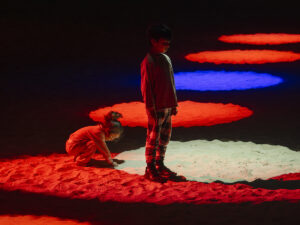I really enjoyed reading this text, particularly discovering the artworks on surveillance. I find it quite ironic (but in a good way) that a lot of artworks that want to talk about surveillance, employ some sort of surveillance themselves. Of course, here, surveillance has to be looked at in the wider sense. Usually, when we think surveillance we imagine CCTV or hidden cameras. However, as the text mentions, human tracking is also included under surveillance. So, even artworks that simply track your body movements, as basic as the Cheese installation by Möller, can be said to be «surveilling» you in a way. There are also the other forms of human tracking, like Lozano-Hemmer’s Standards and Double Standards, which involve more intense forms of surveillance and tracking. To have items following you takes the «scrutiny» to a different level. Reading about this artwork reminded me of the Manar Abu Dhabi exhibition which took place last fall. It included 35 artworks, many of which were installations. The one that Lozano-Hemmer’s work reminded me of is the Abu Dhabi Dots by Carsten Höller, which was exhibited on the shore of the Corniche beach. Essentially, there are projected spotlights on the sand, and when you stand on them and move, they move with you.
After reading about it now, I found out that it is actually a game. Here is the description:
But if a series of red dots join an interrupted chain or cluster, the dots all become white. If not, the game continues until 7 or more white dots don’t overlap with other white dots any more.”
Before reading this text, I hadn’t thought much about it, but now I realize that it is a form of tracking after all. And although it seems like a game for children, the whole «reward and punishment» part of it actually reminds me a bit of surveillance and scrutiny, where your actions can favor you but also disadvantage you, while also impacting other people around you. It is therefore interesting to see how computer-based tracking artworks feed into the idea of surveillance, and potentially how they use our data (and store them?).

